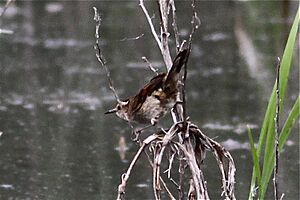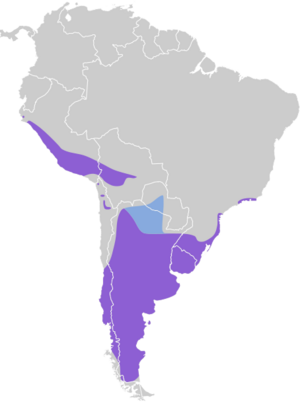Wren-like rushbird facts for kids
Quick facts for kids Wren-like rushbird |
|
|---|---|
 |
|
| Conservation status | |
| Scientific classification | |
| Genus: |
Phleocryptes
|
| Species: |
melanops
|
 |
|
The wren-like rushbird (its scientific name is Phleocryptes melanops) is a small bird. It belongs to the ovenbird family called Furnariidae. You can find this bird in several South American countries. These include Argentina, Bolivia, Brazil, Chile, Paraguay, Peru, and Uruguay.
Contents
About the Wren-like Rushbird's Family
The wren-like rushbird is special because it's the only bird in its group, called a genus. Its genus name is Phleocryptes. There are four types, or subspecies, of the wren-like rushbird:
- P. m. brunnescens (discovered by Zimmer in 1935)
- P. m. schoenobaenus (discovered by Cabanis & Heine in 1860)
- P. m. loaensis (discovered by Philippi Bañados & Goodall in 1946)
- P. m. melanops (discovered by Vieillot in 1817)
This bird is most closely related to another bird called the curve-billed reedhaunter.
What the Wren-like Rushbird Looks Like
The wren-like rushbird is a small bird. It is about 13 to 14 cm (5.1 to 5.5 in) long. It weighs around 11 to 16 g (0.39 to 0.56 oz). Its feathers look a lot like those of a different bird, the marsh wren. It has a bill that is a bit long and curves slightly downwards. Male and female birds look very similar. Females are just a little bit lighter in color.
Adult birds have a wide, light brown stripe above their eye. They have grayish feathers near their eyes. There is a dark brown band behind each eye. Their cheek area is light brown. The top of their head is blackish with brown stripes. Their back is blackish with rich brown stripes. They also have clear white lines on their feathers. Their lower back and upper tail feathers are rich brown.
Their tail feathers are mostly blackish-brown. The inner ones are rich brown. Their wing feathers are blackish. They have chestnut and reddish-brown edges. These edges form a wide band when the wing is closed. Their throat is white. Their chest and belly are light whitish-brown. Their sides are dull brown. Their under-tail feathers are a mix of light brown and white. Their eyes are brown. Their bill is dark, sometimes lighter at the bottom. Their legs and feet are grayish. Young birds look like adults but have thin dark edges on their belly feathers.
The different types of wren-like rushbirds have small differences. For example, P. m. schoenobaenus is bigger and has a longer bill. Its upper feathers are brighter. P. m. brunnescens has a lighter but more striped head. Its back is browner. P. m. loaensis is similar but has a darker wing band.
Where the Wren-like Rushbird Lives
The different types of wren-like rushbirds live in various places:
- P. m. brunnescens: Lives along the coast of western Peru.
- P. m. schoenobaenus: Found in central and southern Peru, western Bolivia, and northwestern Argentina.
- P. m. loaensis: Lives along the coast in southern Peru and northern Chile.
- P. m. melanops: Found from southern Brazil south through Uruguay, central Chile, and most of Argentina. During the non-breeding season, it moves to northern Argentina and Paraguay.
This bird likes to live in freshwater and salty marshes. It also lives at the edges of lakes. It especially likes areas with tall water plants like sedges. It can live from sea level up to 4,300 m (14,100 ft) high in the mountains.
How the Wren-like Rushbird Acts
General Behavior
The wren-like rushbird not only looks like the marsh wren, but it also acts like it. Both birds often perch on plants. They grip a different plant stem with each foot.
Where it Travels
The wren-like rushbird is a partial migrant. This means some of the birds move to different places. Some birds from the southern areas fly north during the southern winter. They go to northern Argentina and Paraguay at that time.
What it Eats
The wren-like rushbird eats small bugs and insects, called arthropods. It finds its food by picking it off floating plants or plants sticking out of the water. It also searches for food in the mud of the marsh.
Reproduction and Life Cycle
Wren-like rushbirds usually breed during the southern spring and summer. This is generally from September to January. The exact timing can change a bit depending on the area. Scientists think these birds are monogamous. This means a male and female bird stay together to raise their young.
The bird builds a round nest. It uses wet grass and other plant fibers. It glues them together with mud. The inside of the nest is lined with feathers and hair. The nest has an opening on the side. This opening often has a small "awning" over it. The bird attaches its nest to several reeds or plant stems. It usually places the nest within 1 m (3 ft) above the water.
A female bird lays one to four eggs. Studies have shown that the eggs hatch after 16 to 18 days. The young birds leave the nest about 16 days after they hatch. We don't know much about how the parents care for their young.
Sounds it Makes
In many places where it lives, the wren-like rushbird's song sounds like a repeated ticking noise. It makes this sound several times per second. Sometimes it sings for several minutes. The song often ends with a trill, like the sound a cicada makes. One person described it as sounding "like an idling motor." The song of birds in the Andes mountains is similar but has "more strident tones." The bird also makes other sounds. These include a "buzzy 'zzt'," a nasal "ik" or "eh," and various squeaky notes.
Conservation Status
The IUCN (International Union for Conservation of Nature) has looked at the wren-like rushbird. They have listed it as a species of "Least Concern." This means it is not currently in danger of disappearing. It lives in a very large area. However, we don't know how many of these birds there are. Their numbers are thought to be going down. No immediate threats have been found.
The bird is generally common where it lives. But it depends on wetlands with plants growing in the water. This makes it a bit vulnerable. Many local groups of these birds have become much smaller. Some have even disappeared because their homes have been destroyed. The birds living in the Andes and along the Pacific coast are especially at risk.


